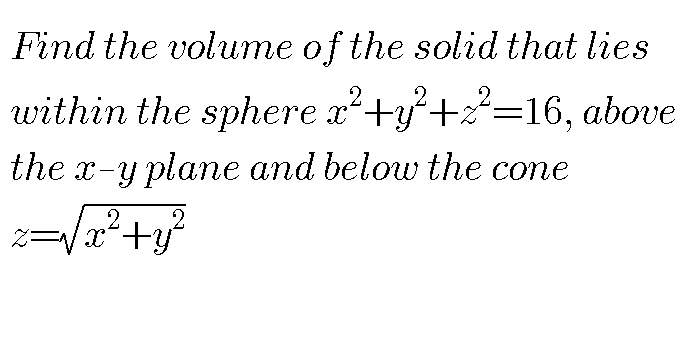
AllQuestion and Answers: Page 1388
Question Number 74266 Answers: 0 Comments: 0
Question Number 74265 Answers: 1 Comments: 0
Question Number 74264 Answers: 0 Comments: 1
$$\int_{\mathrm{0}} ^{{x}} {xe}^{{x}} \mathrm{sin}\:{e}^{{x}} {e}^{{x}} {dx} \\ $$
Question Number 74263 Answers: 0 Comments: 1
$$\int_{\mathrm{0}} ^{{x}} {e}^{{x}} \mathrm{cos}\:{e}^{{x}} {e}^{{x}} {dx} \\ $$
Question Number 74246 Answers: 2 Comments: 0

Question Number 74244 Answers: 2 Comments: 0
Question Number 74240 Answers: 1 Comments: 3

Question Number 74235 Answers: 3 Comments: 0

Question Number 74234 Answers: 0 Comments: 0
Question Number 74231 Answers: 1 Comments: 2

Question Number 74226 Answers: 0 Comments: 0

Question Number 74225 Answers: 1 Comments: 0
Question Number 74224 Answers: 1 Comments: 2
Question Number 74223 Answers: 1 Comments: 0
Question Number 74219 Answers: 0 Comments: 0

Question Number 74218 Answers: 1 Comments: 0
Question Number 74214 Answers: 1 Comments: 0

Question Number 74213 Answers: 2 Comments: 1

Question Number 74211 Answers: 0 Comments: 1

Question Number 74210 Answers: 1 Comments: 0
Question Number 74209 Answers: 1 Comments: 0

Question Number 74207 Answers: 0 Comments: 0

Question Number 74196 Answers: 0 Comments: 1
$${solve}\:{for}\:{x}: \\ $$$$\mathrm{4}^{{x}} +\mathrm{6}^{{x}} =\mathrm{9}^{{x}} \\ $$
Question Number 74191 Answers: 2 Comments: 0
Question Number 74187 Answers: 0 Comments: 0

Question Number 74181 Answers: 1 Comments: 0

Pg 1383 Pg 1384 Pg 1385 Pg 1386 Pg 1387 Pg 1388 Pg 1389 Pg 1390 Pg 1391 Pg 1392
